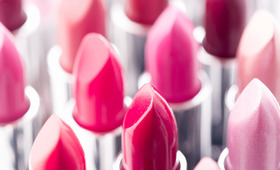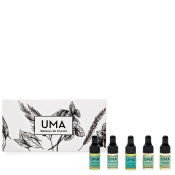How UMA Sources the World’s Best Essential Oils
Published Jun 12, 2019
Shrankhla Holecek’s family has been producing essential oils for the world’s top beauty brands (think TOM FORD and Estée Lauder) for years. So when Shrankhla launched UMA as a way to share her family’s legendary oil blends with the world, industry insiders (and more than a few celebrities) took note. We asked Shrankhla to explain the special process UMA uses to source its essential oils. (Spoiler alert: Not all essential oils are created equal!)
UMA.
At the UMA estate, we have been striving for centuries to create only the highest quality essential oils, and we want you to know exactly how we ensure that. I’m about to get a little technical, but bear with me. We think it’s important that you know exactly where your essential oils are coming from. Here’s the rundown on essential oil production—and why we do it our way, which isn’t necessarily the easy way.

What’s the story behind essential oils?
These potent ingredients have an equally rich history. Ancient Egyptians were among the first to use essential oils in medical practices, religious ceremonies, spiritual enhancement, and, of course, embalming. When tombs are uncovered today, traces of cedarwood and myrrh are common discoveries. There are over 150 references to essential oils in the Bible—including the well-known story from the New Testament about the baby Jesus receiving gifts of frankincense and myrrh from three wise men.
The obsession didn’t stop! The reintroduction of essential oils into modern medicine first began during the late 19th and early 20th centuries. Since that time, essential oils have been used to kill harmful germs, balance the mood, lift spirits and dispel negative emotions. At UMA, we use centuries of ancient wisdom about essential oils in order to create highly effective, pure blends that are perfectly suited for modern day.
Where do essential oils come from?
Essential oils are commonly derived from the berries, seeds, bark, rhizome, leaves, flowers, and fruit peels of plants. At our estate, we grow and manage many unique types of crops—something we do completely organically and sustainably. One of my favorite essential oils—the extremely precious sandalwood—is derived from the wood of a tree that takes over 15 years to mature!

How are essential oils extracted from these plants?
There are several methods for extracting essential oils, and more sophisticated methods come with a higher price tag. As you may guess, the less expensive methods—which we don’t believe yield the highest-impact results—are a common choice for companies looking to cut corners.
-
Distillation. Water is heated to produce steam, and the steam softens and ruptures plant cells to release the volatile compounds that make up essential oils. The steam flows through a condenser (think a vertical glass tube that’s hundreds of feet long!), cools, and becomes a liquid. Finally, the material collected at the surface is the essential oil. This is the method we typically use at UMA because it gently yet effectively creates quality oils. The process is ultra-sensitive—time, temperature, and pressure must be constantly monitored—but we love giving our oils a little extra TLC to ensure our customers have the best possible product.
-
Expression/cold-pressing. This is the method used to produce most citrus oils, like orange or lemon. A lot of pressure is applied to the fruit peel to break open oil glands under the surface. Citrus peels contain lots of oil, which means they are more easily extracted, making them less expensive than other essential oils. While we love the benefits of essential oils like orange, our products are bursting with other, more precious ingredients to give our customers the best possible results.
-
Solvent extraction. This relatively inexpensive method is typically used for oils like jasmine or tuberose, because their chemical composition makes it difficult to use other means. An organic solvent like hexane or methanol is used to wash the plant material, eventually separating out the oil from the solid stuff. While the solvent usually evaporates, traces of it can often be found in the products. We don’t use this method—purity is our middle name!
-
Supercritical fluid extraction (SFE). This method is fairly similar to the one above, but it is completely nontoxic and odorless. Supercritical carbon dioxide is used as the solvent to extract the essential oil and then converts into a gas, leaving a solvent-free product. The carbon dioxide is even recyclable—talk about sustainable!
-
Enfleurage. This old-school process was beloved by the Ancient Egyptians. Glass trays are covered in an animal or plant fat, and then flowers are placed on top and left for days or weeks. The fat absorbs the essential oil, and the fat is solubilized with alcohol. After the alcohol evaporates— voila! —you have an essential oil. This method has fallen out of favor because fats do not extract oils as well as an alcohol solvent, leaving you with weaker results. Although we incorporate many traditions in the creation of our essential oils, this is not one of them, as we want to create only the purest essential oils.
Hopefully, by reading this, you’ve learned that not all essential oils are created equal. We put a lot of hard work, patience and research into every ingredient that goes into every bottle. “Purity,” “quality,” and “organic” aren’t just words for us—they’re the way we do business. We know that by setting these standards and living up to them, our customers are getting the best possible product with no strings attached.
Featured Products
You Might Also Like
-

Brown Girl Beauty
Exploring The Wonders Of The Weave: Part 1
- 85
-

Counter Confidential
Counter Confidential: For the Love of Lips
- 118
-

Stories
COVID-19: Jouer Cosmetics Creates a New Product to Help Frontline Warriors
- 1
-

Behind the Brand
Get to Know Natasha Denona
- 47
-

Expert Skin Care Advice
What is Retinol?
- 320
-

Wellness
5 Supplements to Manage Stress During the Holiday Season









